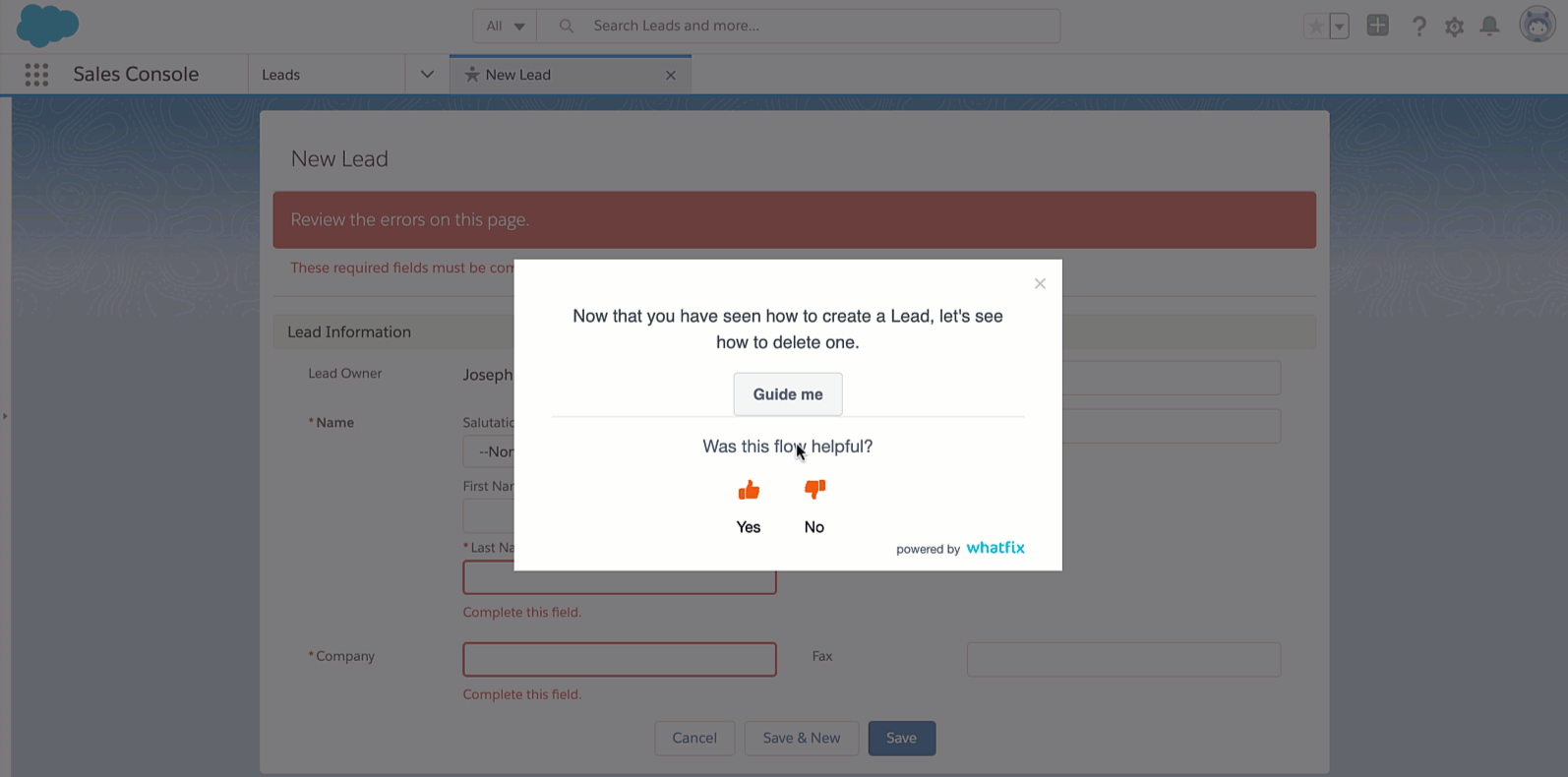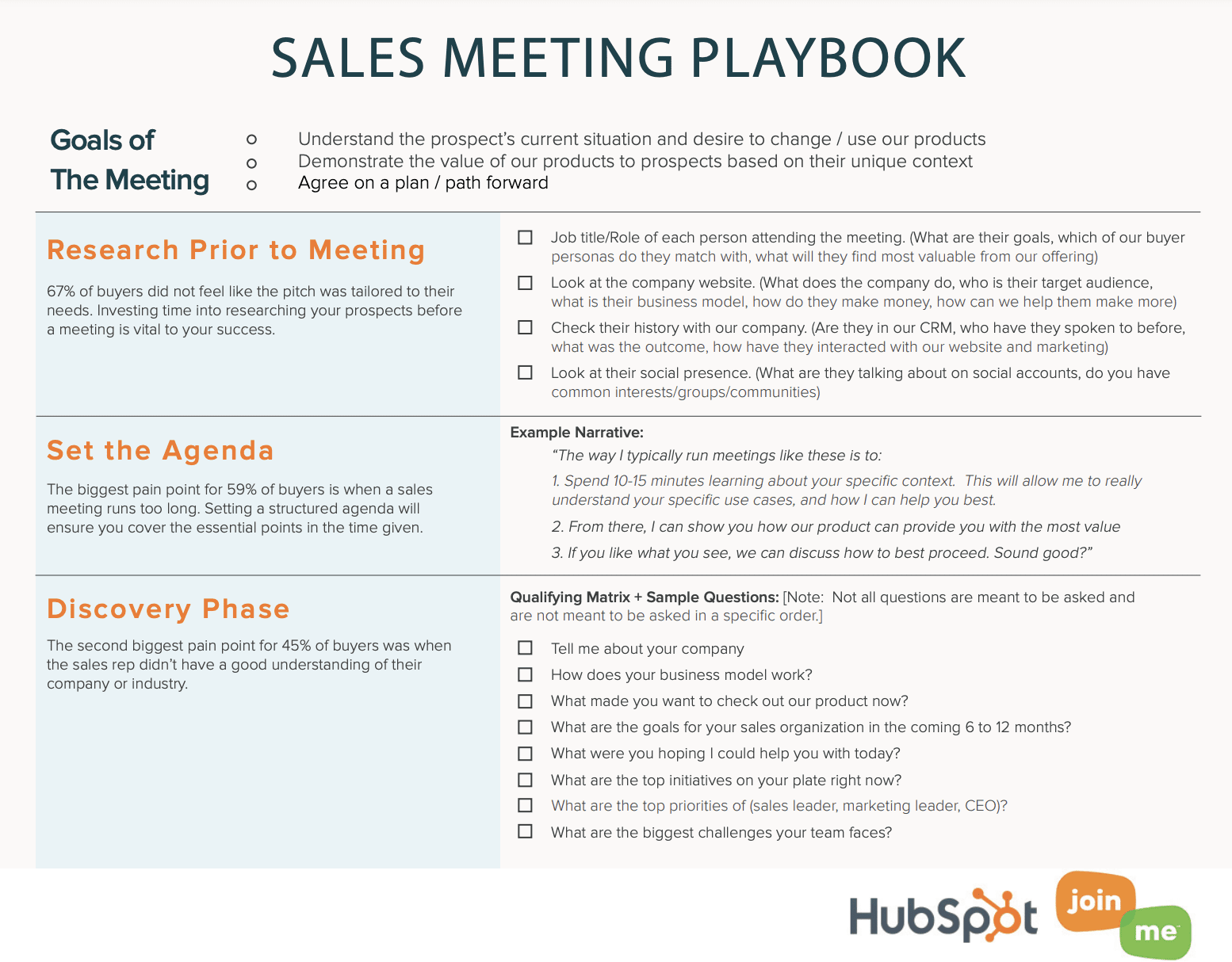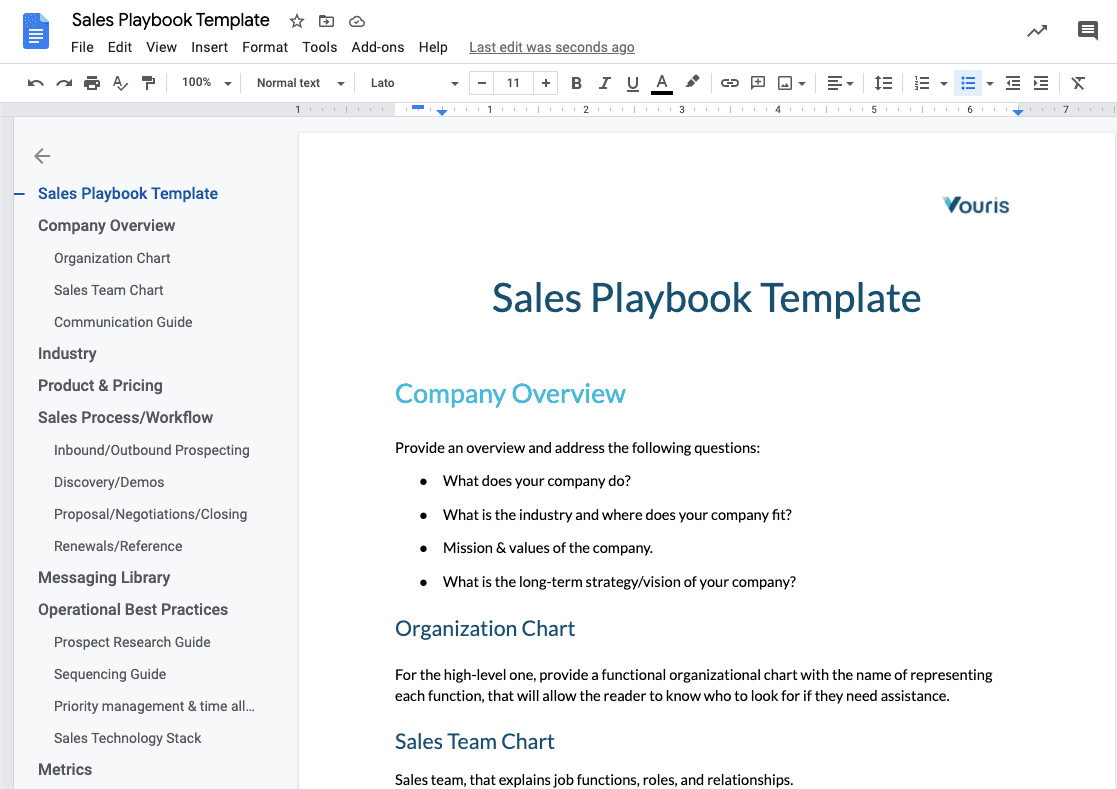
Access to the right knowledge at the right time is crucial in sales. In a fast-paced and competitive field, even the slightest misstep or oversight can make or break a deal.
That’s why it’s essential to equip your sales reps with everything they need to do their jobs more effectively and close more deals. Ideally, this includes outlining expectations and processes to secure repeatable success.
In order to make success repeatable, sales teams need to use sales playbooks.
Benefits of a Sales Playbook
- More efficient onboarding
- Increase team productivity
- Consistent sales approach
- Better prospecting
- Accelerate the sales process
What Is a Sales Playbook?
A sales playbook is an all-encompassing resource that sales teams use to outline best practices, tactics, and strategies during each stage of the sales cycle. It details what a sales rep should do in any given situation and provides all the necessary information your sellers need to be successful.
A sales playbook is made up of documented buyer personas, sales strategies, important KPIs, discovery call questions, sales process details, and other sales materials. By consolidating every email, pitch, script, and tactic that’s worked for your sales team into one easy-to-read process document, you can easily distribute, reference, and optimize it on an ongoing basis.
A sales playbook is more than a compilation of scripts and strategies, though. It serves as an accessible standard operating procedure (SOP) for navigating common sales challenges, ramping up sales onboarding, and increasing seller productivity.
Sales playbooks ensure wins are intentional, and losses are tracked and dealt with at whatever point they occur. When done right, sales playbooks empower sellers to effectively engage with customers and adapt to any selling situation they encounter.
In this article, we’ll discuss how to create a winning playbook and provide helpful tips, templates, and tools for your sales team to utilize.
5 Benefits of a Sales Playbook
While the thought of creating a sales playbook might seem like a time-consuming endeavor, there’s no denying the tremendous return on investment.
A sales playbook is designed to support both new hires in their new role and tenured vets of the field, keeping the basics easily accessible for sellers and other involved stakeholders. It’s all about providing your team with the tools they need to be successful.
Here are five benefits of having a sales playbook in place:
1. More efficient onboarding
Ramping up new employee onboarding is exponentially more efficient when you have detailed explanations of the structure of your business, who your target customers are, how your product works, and best practices for success.
Without a sales playbook, your new sales reps are forced to learn on the fly and act at random with no structure or guidance. The faster you can get new hires up-to-speed and closing deals, the more value you’ll be able to get from your reps.
2. Increase team productivity
Equipping your sales team with a playbook will increase your sales effectiveness and productivity tenfold.
A sales playbook contains all of the content your sales team needs – meaning your reps don’t have to go searching through archives of documents and SOPs when they’re on a client call. This frees up more time for building rapport with prospects and moving them through the pipeline.
Sales managers also spend less time coaching and training, and will be able to devote more time navigating difficult and unique sales scenarios, as well as overseeing team operations.
When you arm your sales reps with detailed processes and ready-to-use sales enablement content, you’ll help them save time by eliminating the need for them to constantly re-invent the wheel with their own messaging, content, and resources.
3. Consistent sales approach
A sales playbook is a valuable tool for sales teams because it empowers everyone on the team with the same knowledge and access to resources as they work to achieve their goals.
Your sales playbook will serve as the centralized blueprint of your sales processes and best practices. Managers can ensure sales reps are conducting themselves and their client relationships in accordance with company values and goals.
From new hires to seasoned sellers, your sales playbook will keep everyone on the same page, provide consistent performance, and ensure profitable outcomes.
4. Better prospecting
By creating a sales playbook, sales managers clearly define the ideal customer and the various market conditions, trends, pain points, and intricacies that influence buying decisions.
Including customer profiles in your sales playbook helps your team navigate prospect conversations, anticipate customer needs, answer common questions, and handle typical objections. They provide a framework for helping both your sales and marketing teams to identify, target, and convert qualified leads.
5. Accelerate the sales process
The sale cycle is shortened, or accelerated, when a sales playbook is used to facilitate each stage of the process – from prospecting, to pitching, to closing.
Sales acceleration refers to a series of strategies that take a lead from prospect client to closed customer faster. Sales reps will be able to navigate through the sales process more efficiently if the steps on how to do so are properly defined, outlined, and documented. Having everyone on the same page will help to avoid costly mistakes that slow down the process.
Guided selling with the help of a sales playbook allows sales reps to focus on what matters most– solving the customer’s problem. The shorter the sales cycle is, the sooner you may get to this stage of the process.
Sales Playbook vs Sales Process vs Sales Methodology
Sales playbook, sales process, sales methodology – all such similar terminology. But what do these concepts mean, and how do they impact your sales team?
The sales process is an outlined series of repeatable steps that guide your sellers from prospecting to closing. It equips your sales reps with everything they need to be successful at every stage and provides meaningful structure to the sales cycle.
Your sales methodology is a set of principles and best practices on how salespeople approach each step in the sales process. It’s your company’s selling philosophy and defines how you approach your target customers.
The most successful sales teams have all three components in place. If you think about it in the simplest sense, your target customer drives your company values, mission, and goals.
Your company values then shape your sales methodology, your sales methodology builds your sales process, and your sales process makes up your sales playbook. They all work in conjunction to produce the most reliable, repeatable, profitable outcomes for your sales team.
6 Elements to Include in Your Sales Playbook
In the earlier days of sales, things were simpler – which meant simpler processes and simpler playbooks. As the field has evolved, sales playbooks have followed suit.
Knowledge is power in sales, and having the right information your sales reps need right at their fingertips puts them in the best position to close more deals.
Here are six important elements to include in your sales playbook:
1. Company and team structure
For new hires and seasoned sellers alike, knowing the structure of the organization and their respective teams make collaborative efforts even more effective.
Define each departments’ responsibilities and have a brief overview of individual members’ day-to-day. Having an understanding of who to go to during any stage of the sales process allows your sales reps to cut down on time wasted looking for the problem solver, and makes more time for working with teams who can provide impactful resources to help land a sale.
2. Product or service details
To help your salespeople confidently navigate prospect conversations or product demos, they’ll need to be experts at the thing they’re selling – your product or service your business is offering.
Highlight the benefits of your product or service, explain why users should buy it, and prepare to answer customer questions or common objections. In your product knowledge training, be sure to cover every major aspect including various price points, unique use cases, core benefits, customer success stories, and others.
Providing this information will help sellers focus on the most important points of the pitch and communicate the value to prospects when time is of the essence.
This does not, however, need to be a deep dive into how your product works or the excessive technical details of your service. Instead, focus on giving an overview of what the product does and why the features matter. This positions your product in feature-benefit language that speaks to customer needs.
3. Sales process & sales methodology
Your sales process tells your sellers which checkpoints they need to hit to lead a prospect to close. Explain each step of your sales process from initial outreach to signing the deal, and include best practices and helpful tips. You can outline the process within the playbook or simply link to your sales process document so reps and sales managers can easily reference it.
To influence the way your reps approach the sales process, define your sales methodology in your sales playbook. Ensuring all salespeople are following the same methodology helps deliver a consistent message and experience from salesperson to salesperson.
4. Objection-handling talking points
Preparing your sales reps for common objections can help them difficult conversations into positive customer experiences.
Your sales process should have a section on objection handling, but it’s also important to highlight within your sales playbook. With training, objections can be an opportunity for salespeople to show the prospect they understand their concerns and to share content that addresses them head-on.
Dealing with objections promptly and professionally can prevent them from bringing the sales process to a screeching halt. The way sales reps deal with objections can paint a picture of how sales reps nurture client connections and help build their relationship with prospects.
5. KPIs
Everyone knows metrics tell an impactful story, but which ones matter most to your sales teams? Which ones do your sales managers track most closely? Which ones should your sales reps be paying attention to? Are there any baseline numbers sales reps should know about? These are all important questions to ask when deciding which metrics to hone in on and measure performance with.
Revenue is everyone’s obvious focus, but you’d be remiss not to think about other performance objectives to measure that demonstrate just how valuable your product or service is. If your team has a clear understanding of how their performance will be measured, they’ll be more inclined to do everything they can to hit their goals.
6. Customer profile
The purpose of your sales playbook is to help sales reps meet leads where they are. It’s meant to help sellers connect with prospects by leading them through each stage of the sales process, so developing a customer profile will ensure you’re targeting customers who are most likely to convert.
Collect as much information as possible about your target customer’s unique needs, challenges, questions, and objections, and share these insights with your sales reps. Especially if you have several products that appeal to different customer groups, knowing what, or who they’re dealing with allows your sales reps to tailor their approach appropriately.
However, as your business grows, your product line expands, and your target customer group evolves, be sure to continually update your buyer personas. Revisit your customer profile on an as-needed basis and include insights you gain from sales reps with every consultation and close.
4 Tips for Writing a Winning Sales Playbook
Your sales playbook is unique to your business and sales team — however, the following tips for creating a sales playbook apply to virtually any business’s sales team:
1. Determine your goals
Before you dive into the contents that will make up your playbook, start by defining what you want to achieve and what outcome you’re hoping for.
Ask yourself questions that can get your goals rolling– are you hoping for better documentation of your process? More structure for your team? Better collaborating across departments? Also consider timeline-oriented goals – will you set a first draft due date? When should be finalized? Will you do one massive team-wide roll-out or test with selected participants?
Your sales reps are goal-oriented by nature, which is what makes them so good at their job. By making your playbook goals specific, your sales reps will be more likely to adapt to the best practices and work toward those goals with intention and clarity.
2. Decide playbook contributors
As with most company initiatives, effective documentation takes a village. For such a massive catalog of information to be owned by one team (or person) is a huge undertaking and doesn’t make for well-rounded content.
Determine who you want to be involved in the creation process so you can invite them to collaborate and provide their insight. The people you’ll likely want to be involved in the process may include:
- Marketing team members
- Sales reps
- Product experts
- Sales VPs, directors, and managers
- Tech and support specialists
It’s also important to specify who will be responsible for actually creating and drafting your sales playbook so other contributors know who’s leading the effort and who they can reach out to with questions and feedback. If this falls on multiple contributors, make sure all authors are properly identified.
3. Make use of existing content
The purpose of a sales playbook is to provide sales reps with context-specific content to facilitate conversations and support interactions with prospects and current clients. Rather than starting from scratch or forcing your sales rep to think on their feet, use the content you already have at your disposal.
In business, content comes in two different forms:
- External content refers to content that you openly share with customers or other outside parties. This type of content often features information that’s available to the public and is not gated by any individual or group. Some examples include white papers, testimonials, articles, case studies, product presentations, and package offerings.
- Internal content is designed for the salesperson to use and is not to be shared with prospects or current customers. This content either includes sensitive information or reveals too much of the interworkings of the sales team or organization. Some examples of internal content include product decks, training content, email templates, and pitch scripts.
Make sure both your internal and external resources are current, organized, easily accessible, and properly tailored to each prospect. Take inventory of the content in your company library, make any necessary updates or revisions, and offer it to your sales team as a revamped resource. The more you can leverage existing content, the more unified your organization will feel and appear.
4. Provide training for sales reps
No matter how solid your product, processes, or playbook are, you’re not going to see impactful results unless you properly train your sales team.
Start by ensuring that your salespeople have an expert understanding of your product’s capabilities and features. Have your product specialists demo the usage and navigation, let your sales reps trial it live and test its functionality, and have them showcase how they’d sell it to a prospective customer. Take the time to coach them and let them prove their expertise.
Brainstorm ways to encourage and host ongoing training sessions with your sales team when processes change or updates are made to your playbook. Find ways to incentivize your sellers to participate in the trainings and make your training content engaging and accessible.
Next, properly train your sales reps on how to navigate and utilize your sales playbook to its fullest potential. With so much valuable content, it’s important to understand how your playbook is organized and where to find the answers your sales reps need right when they need them. Whatfix offers step-by-step walkthroughs that provide users with an interactive way to learn on the go– perfect for getting your sales team up-to-speed on a vast and valuable resource like your sales playbook.
5 Ways to Revamp Your Existing Sales Playbook
A sales playbook will increase efficiency in your team and improve close rates across the board. But don’t let it grow stale – regularly revisit and revamp your sales playbook as your sales processes change, your product line expands or shrinks, your target customer evolves, your strategy shifts, or your team or org structure is restructured.
Here are five tips for revamping your existing sales playbook:
1. Monitor the performance of your current playbook
Similarly to everything else in business, it’s crucial to analyze and monitor the success of your work. Once your sales playbook has been shared and used by your sales team, keep tabs on its relevance, success, and helpfulness.
Refer back to the goals you set for your playbook and break down the performance of each element. Are you seeing the results you anticipated? What areas are you underperforming, and have you identified any reasonable roadblocks? You can’t enhance what you don’t observe.
With Whatfix, you can monitor what in-app content is being utilized the most – and what isn’t. This provides valuable insight into what areas of your digital processes and CRM aren’t being used properly – and where you should be creating additional training and support content to help get your reps more familiarized with these functionalities.

2. Review messaging
The messaging of your sales playbook is not just about outlining what to say, but how to say it.
When your sales reps are preparing for an upcoming prospect meeting, the messaging of your playbook serves as a useful guide to demonstrate the impact of your product or service, ask the right questions, and effectively handle common objections and pushback – all with a consistent, uniform approach.
Refining your playbook messaging and sharing it with all essential teams– including sales, marketing, and product– helps align your company’s approach so potential customers have a positive experience from opening to close. Being cohesive and consistent is key.
3. Collect internal feedback
If sales reps see positive results with specific tactics, messaging, or other outreach methods, use their success to shape your playbook.
Ask sellers for feedback on your current sales playbook – how easy it is to navigate, how current the content is, if additional resources or documents are required, and so on. Since your sales reps are the ones out in the field having conversations with prospects and nurturing relationships from awareness to purchase, they can help you fine-tune your approach based on what’s working and what’s not.
You might consider conducting a survey to gather this feedback more efficiently so you can effectively update and edit the playbook as needed. Sending out a digital survey every quarter will help you keep a finger on the pulse of your sales playbook performance.
With Whatfix, learning and development leaders are able to collect data on their sales playbooks’ effectiveness and helpfulness in the flow of work, right inside your CRM or digital processes.

4. Make it accessible
Sales playbooks can only be as effective as they are accessible. It doesn’t matter how good your sales playbook is – if people can’t access it, it’s a waste of valuable information and resources.
When all teams can properly navigate to and access your sales playbook, everyone is better equipped to follow best practices, practice consistency messaging, and ultimately maintain the efficacy of the playbook. It makes it easier for users to get their hands on the right information right when they need it instead of jumping from folder to folder searching for what they need.
Gone are the days of hard copies and printed manuals – consider creating a digital playbook and saving it to your company’s shared drive. Show your team where the document lives and make sure everyone has proper access, whether that be view-only or editing capabilities.
Sales leaders should look to technology to help make their sales documentation more accessible, with tools such as:
- Knowledge base
- Intranet portals
- Shared drives
With Whatfix, embed your sales playbook, best practices, and scripts directly into your sales tools in the form of task lists, guided messages, and tooltips – as well as provide on-demand self-help support by embedding contextual links to documentation in your knowledge base, drive, or intranet portal.
5. Update and add helpful resources
You likely have an entire collection of underutilized resources tucked away in your company’s drive. Instead of letting them stay stagnant and siloed, put them to use by incorporating them into your sales playbook.
SOPs, product descriptions, client testimonials, competitor analyses– these are all excellent resources that salespeople can benefit from when nurturing a lead through the sales process. By including them in your sales playbook, sales reps will be able to access ready-to-use resources that will boost sales performance and close more deals.
Be sure to include a variety of resources that are tailored to your different buyer personas. A one-size-fits-all strategy isn’t optimal in this situation, and you want to equip your sales reps with the materials that will resonate best with each group they’re targeting.
3 Sales Playbook Template Examples
If you’re new to the sales playbook game, it might be difficult to know where to begin when creating your own guide.
To help you get started, we’ve compiled three excellent sales playbook template examples:
1. Hubspot
In Hubspot’s free template, you’ll be able to work through your sales plan and playbook at the same time to ensure they’re consistent and work harmoniously. Compile your company’s sales strategy and processes in one simple template and align your teams on your goals, messaging, and best practices.
2. Revenue
In order to ramp up new hires as quickly and efficiently as possible, it is essential to outline the onboarding process. Revenue offers a new-hire ramping playbook that includes 3 types of onboarding material, a day-by-day guide to ramp new hires in 6 weeks, and more.
3. Vouris
Vouris generously provides a free Google Doc version of a sales playbook template, making it easily accessible and customizable. The template includes sections on your company overview, product, messaging, and best practices – all elements of a winning playbook. Simply download or make a copy of the doc template and start customizing.
3 Tools to Create & Manage Your Sales Playbook
Some people like to take things into their own hands. If that sounds like you and your sales managers, you’ll likely need some tools to get started on creating your sales playbook template and managing it over time.
Here are three tools you can use to help create and manage your sales playbook:
1. Bit
Bit makes it easy to create a sales playbook with the use of workspaces. Create a workspace around a team, department, large project, client, or partner, then add your team members, and finally add your own content to the available sales playbook template.
2. Survey Monkey
Gather feedback from your employees to shape your sales playbook with SurveyMonkey. That feedback will provide an idea of current usage and areas of opportunity. Questions to consider for your survey may include:
- How often are they using the playbook
- Is there anything they feel is missing?
- Is there anything that needs to be updated?
- Is it easily accessible?
- Is it easy to navigate?
3. Whatfix
Given how fast-paced sales can be– between prospecting research, client calls, meetings, and traveling– it can be difficult to align manager and sales rep schedules for coaching opportunities. With Whatfix, you can get the maximum value from your sales playbook by easily navigating its contents.
Whatfix provides contextual walkthroughs on how to navigate your sales playbook and all of its elements. Sellers can utilize an in-app self-help wiki that allows them to search through their teams’ sales documentation and templates whenever they need them.
Sales Playbook
FAQs
What is a sales playbook?
A sales playbook is an all-encompassing resource that sales teams use to outline best practices, tactics, and strategies during each stage of the sales cycle.
What is the difference between a sales playbook, sales process, and sales methodology?
A sales playbook is a compilation of documented buyer personas, sales strategies, important KPIs, discovery call questions, sales process details, and other sales materials.
The sales process is an outlined series of repeatable steps that guide your sellers from prospecting to closing.
Your sales methodology is your company’s selling philosophy and defines how you approach your target customers.
What should I include in my sales playbook?
- Company and team structure
- Product or service details
- Sales process & sales methodology
- Objection-handling talking points
- KPIs
- Customer profile
The purpose of a sales playbook is to equip your sales team with all the information they need to be successful. Clearly-defined processes and accessible, updated resources empower sales reps to provide a positive, impactful experience for prospects from awareness to closing. Whatfix can make navigating those accessible resources even more efficient.
Using Whatfix, you can create guided walkthroughs that help your sales reps navigate your sales playbook. Whatfix empowers your sales playbook users throughout the sales cycle to utilize the document and linked resources more impactfully, increasing productivity and driving better sales outcomes.
Learn more about how Whatfix can ramp your sales playbook adoption and accelerate your training opportunities.
Request a demo to see how Whatfix empowers organizations to improve end-user adoption and provide on-demand customer support
Thank you for subscribing!






